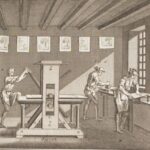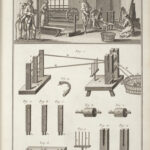Engraving the Plates
- Intaglio printing
- Copperplate
- Passementerie
The plates in the Encyclopédie were created using copperplates in which the image was engraved in reverse. Ink was applied and wiped off the surface, leaving a residue in the recessed lines. Dampened paper was placed on the plate and passed through a rolling press, seen in the print to the right. The resulting image was right-facing.
This type of printing is called “intaglio,” which refers to the process of printing from an incised plate. To demonstrate how it works, the exhibit included a copperplate (left), which was matched with a similar engraving for the Encyclopédie (right). Both the copperplate and the print entitled Passementerie (a word for fancywork to create woven trim for clothing) depict the fabrication of a ribbon of multicolored silk called a nonpareille. To produce this ribbon, silk threads were fused together by passing them through the heated rollers of a mill. They were then sized with glue and wound onto a spool. Nonpareille were most frequently used to ornament women’s dresses and hats.
The copperplate was not executed for the Encyclopédie but for a project initiated at the end of the seventeenth century by the French Academy of Sciences. Called the Description des Arts et Métiers, its aim was to document the mechanical arts and trades. Although the first volumes of the Academy’s publication were not issued until 1761, plates had been produced for it from the project’s inception. Diderot was familiar with them, as his adoption of their characteristic division of a plate to show a workshop vignette and details of tools shows. Indeed, the plates were so close in design that in 1759 Diderot was charged with plagiarism. He was later exonerated.



